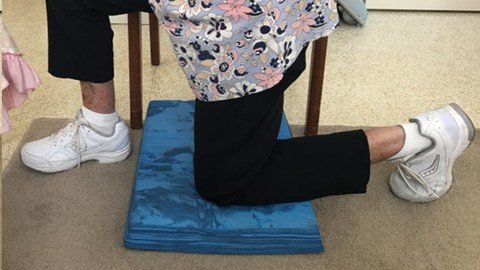Member
LEVEL 7
170 XP

Published 5/2024
MP4 | Video: h264, 1920x1080 | Audio: AAC, 44.1 KHz
Language: English | Size: 538.92 MB | Duration: 1h 14m
Assisting, Assessing and Developing Older Adults' Ability to Get On and Off the Floor
What you'll learn
Safely manage a person who's fallen: a decision making framework for assisting vs. calling for assistance
Assess floor transfers (without risk of clients getting stuck on the ground)
Systematically develop floor transfers: a progression framework
Incorporate floor transfers into therapy sessions: effective session design using the FITT principle
Requirements
This course is suitable for anyone who is involved in helping older adults regain their independence
Description
Helping older adults regain the ability to get up from the floor has an immediate impact on both quality of life and the health system.Getting stuck on the floor is unfortunately very common for older adults. Sometimes it's because the person is injured, but often it's because they just can't get themselves up.So what do you do if you come across an older adult who is on the ground? Should you just call for an ambulance? Or should you try to assist them up?That's the first thing we'll cover in this course.Then, we'll teach you HOW to get them up safely, without risk of injury to both you and then.If someone hasn't fallen and they/you would like to know whether they can get on and off the floor?Well, research shows that many rehab therapists won't even attempt to check this as they're worried they'll get their clients stuck.So here we'll show you a systematic approach to assessing floor transfer capacity that's guaranteed to not get them stuck on the floor(and surpisingly, it only requires items most clients have around the home).Then...What if the client ISN'T able to get up? What if they want to regain independence?In this course we'll show you how to systematically develop floor transfer ability, both:a) Skill progressions for different types of floor transfers, andb) A few different methods for getting on and off the ground(each slightly harder than the previous).So, in this online course you'll learn how to:Safely manage a person who's fallen: a decision making framework for assisting vs. calling for assistanceAssess floor transfers (without risk of clients getting stuck on the ground)Systematically develop floor transfers: a progression frameworkIncorporate floor transfers into therapy sessions: effective session design using the FITT principle
Overview
Section 1: Introduction
Lecture 1 Introduction to Floor Transfer Training
Section 2: Lecture 2: Partner Assisted Floor Transfers
Lecture 2 Lecture 2: Partner Assisted Floor Transfers
Section 3: Lecture 3: Effective Session Design Using the FITT Principle
Lecture 3 Lecture 3: Effective Session Design Using the FITT Principle
Section 4: Lecture 4: Chair Assisted Floor Transfers
Lecture 4 Lecture 4: Chair Assisted Floor Transfers
Section 5: Lecture 5: Hand Assisted Floor Transfers
Lecture 5 Lecture 5: Hand Assisted Floor Transfers
Section 6: Lecture 6: Unassisted Floor Transfers
Lecture 6 Lecture 6: Unassisted Floor Transfers
Section 7: Lecture 7: Conclusion and Next Steps
Lecture 7 Lecture 7: Conclusion and Next Steps
Physiotherapists / Physical Therapists,Occupational Therapists,Exercise Physiologists,Athletic / Personal Trainers
Download file Floor_Transfer_Training_For_Older_Adults.rar
Download Floor_Transfer_Training_For_Older_Adults.rar fast and secure
rapidgator.net
